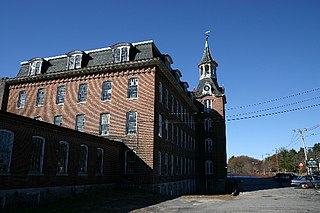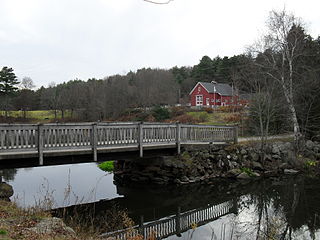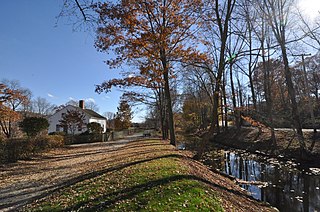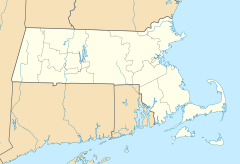
Uxbridge is a town in Worcester County, Massachusetts, United States, first colonized in 1662 and incorporated in 1727. It was originally part of the town of Mendon, and named for the Earl of Uxbridge. The town is located 36 mi (58 km) southwest of Boston and 15 mi (24 km) south-southeast of Worcester, at the midpoint of the Blackstone Valley National Historic Park. The historical society notes that Uxbridge is the "Heart of The Blackstone Valley" and is also known as "the Cradle of the Industrial Revolution". Uxbridge was a prominent Textile center in the American Industrial Revolution. Two Quakers served as national leaders in the American anti-slavery movement. Uxbridge "weaves a tapestry of early America".

The Blackstone Valley or Blackstone River Valley is a region of Massachusetts and Rhode Island. It was a major factor in the American Industrial Revolution. It makes up part of the Blackstone River Valley National Heritage Corridor and National Historical Park.

The Bernat Mill, also known as Capron Mill, and later Bachman Uxbridge Worsted Company, was an American yarn mill in Uxbridge, Massachusetts, that was for the most part destroyed by fire on July 21, 2007.

Daniel Day was an American pioneer in woolen manufacturing.

John Willard Capron was an American military officer in the infantry, state legislator, and textile manufacturer. Famous for being a military uniforms manufacturer, he became Colonel in the army and Chairman of the Board of Selectmen.
Luke Taft was an industrial pioneer in the manufacture of woolens in 19th century New England.

Moses Taft II was born at Uxbridge, Massachusetts. He was significant as an early American Industrialist and financier in the historic Blackstone Valley, and a member of the Taft family.

Linwood is a village with its own post office in the towns of Northbridge and Uxbridge, Massachusetts, United States.

The Blackstone River and Canal Heritage State Park is a part of the state park system of the Commonwealth of Massachusetts, managed by the Massachusetts Department of Conservation and Recreation (DCR). This 1,000-acre (4.0 km2) park "recalls the role of canals in transporting raw materials and manufactured goods between emerging industrial centers." The Blackstone River and Canal Heritage State Park at Uxbridge, Massachusetts, is the midpoint of the Blackstone River Valley National Heritage Corridor of the National Park System. The Blackstone River and Valley is where the industrial revolution was born in America. The southern entrance to this state park is the site of the historic Stanley Woolen Mill, currently being redeveloped for commercial and tourism. The Native American Nipmuc name for the village here was "Wacentug", translated as "bend in the river".

Wheelockville is a village in the town (township) of Uxbridge, Massachusetts, United States. Part of the village centering on Mendon and Henry streets is listed on the National Register of Historic Places as the Wheelockville Historic District. Wheelockville appears on the Blackstone U.S. Geological Survey Map. The Village receives municipal services from Uxbridge, for fire, police, EMS, School district, public works, and other services. Worcester's Judicial District includes Uxbridge District Court. The geography of Wheelockville includes several other distinct mill villages, including: Hecla and Elmdale.

The Waucantuck Mill Complex was a mill complex in Uxbridge, Massachusetts. Despite its 2010 demolition, it is still listed on the National Register of Historic Places.

The Central Woolen Mills District is a historic district in Uxbridge, Massachusetts, USA. The centerpiece of this historic district is the Stanley Woolen Mill, also known as the Central Woolen Mill, built by Moses Taft in 1852, and earlier by his father, Luke Taft, in 1833, on the banks of the Blackstone Canal. The district is the southern entrance to the Blackstone River and Canal Heritage State Park. This parkland is the geographic center of the Blackstone River Valley National Heritage Corridor, an historic corridor of national significance as an example of the earliest industrial activity of the United States.
The Taft family is an American political family of English descent, with origins in Massachusetts. Its members have served in the states of Massachusetts, Ohio, Rhode Island, Utah, and Vermont, and the United States federal government, in various positions such as representative (two), governor of Ohio, governor of Rhode Island, senator (three), secretary of agriculture, attorney general, secretary of war (two), acting secretary of defense, president, and chief justice.
The West River, in the US state of Massachusetts, is a 13.4-mile-long (21.6 km) tributary of the Blackstone River.
The history of Uxbridge, Massachusetts, founded in 1727, may be divided into its prehistory, its colonial history and its modern industrial history. Uxbridge is located on the Massachusetts-Rhode Island state line, and became a center of the earliest industrialized region in the United States.
Jeremiah Wheelock was an American early industrial pioneer in the Blackstone Valley of Massachusetts, a region that incubated the early American industrial revolution.
Richard Mowry became an Uxbridge farmer, in Worcester County, Massachusetts, United States who "successfully built and marketed equipment to manufacture woolen, linen or cotton cloth", from around the time of the Revolution.

Blackstone River Valley National Historical Park is a National Park Service unit in the states of Rhode Island and Massachusetts. The park was created for the purpose of preserving, protecting, and interpreting the industrial heritage of the Blackstone River Valley and the urban, rural, and agricultural landscape of that region. The Blackstone River Valley was the site of some of the earliest successful textile mills in the United States, and these mills contributed significantly to the earliest American Industrial Revolution. The subsequent construction of the Blackstone Canal, a few years after the successful completion of the Erie Canal, helped to sustain the region's industrial strength.

















